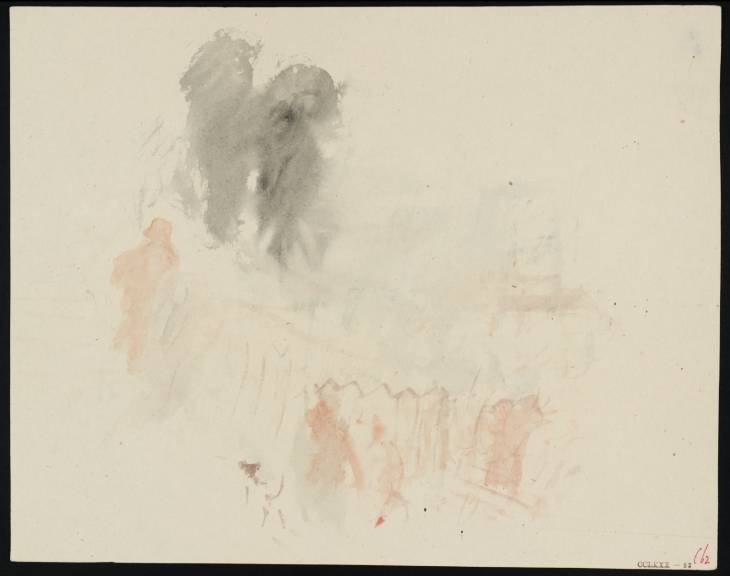Joseph Mallord William Turner Figures at Fence with Dog; Possible Study for 'The Pleasures of Hope' for Campbell's 'Poetical Works' c.1835-6
Joseph Mallord William Turner,
Figures at Fence with Dog; Possible Study for 'The Pleasures of Hope' for Campbell's 'Poetical Works'
c.1835-6
Joseph Mallord William Turner 1775–1851
Figures at Fence with Dog; Possible Study for ‘The Pleasures of Hope’ for Campbell’s ‘Poetical Works’ circa 1835–6
D27579
Turner Bequest CCLXXX 62
Turner Bequest CCLXXX 62
Pencil and watercolour on off-white machine-made cartridge paper, 178 x 227 mm
Inscribed by John Ruskin in red ink ‘(62’ bottom right
Stamped in black ‘CCLXXX 62’ bottom right
Inscribed by John Ruskin in red ink ‘(62’ bottom right
Stamped in black ‘CCLXXX 62’ bottom right
Accepted by the nation as part of the Turner Bequest 1856
References
1909
A.J. Finberg, A Complete Inventory of the Drawings in the Turner Bequest, London 1909, vol.II, p.894, as ‘Possibly for Campbell’s Poems’.
1993
Jan Piggott, Turner’s Vignettes, exhibition catalogue, Tate Gallery, London 1993, pp.95–6.
1999
Peter Bower, Turner’s Later Papers: A Study of the Manufacture, Selection and Use of his Drawing Papers 1820–1851, exhibition catalogue, Tate Gallery, London 1999, p.59.
This work is one of a group of more than thirty watercolour sketches that appear to be experimental preparatory designs for Edward Moxon’s 1837 edition of The Poetical Works of Thomas Campbell.1 Despite the loose, schematic nature of the study it is possible to identify several figures standing beside a fence, with a small house and trees in the background. In the centre of the foreground stands a little dog, its alert manner effectively conveyed with sparing brushstrokes. The subject reflects lines from the poem ‘The Pleasures of Hope’, in which Campbell describes an impoverished vagabond who gazes longingly at a homely cottage and garden:
Yon friendless man, at whose dejected eye
Th’unfeeling proud one looks – and passes by,
Condemn’d on Penury’s barren path to roam,
Scorned by the world, and left without a home –
Even he, at evening, should he chance to stray
Down by the hamlet’s hawthorn-scented way,
Where, round the cot’s romantic glade, are seen
The blossom’d bean-field, and the sloping green,
Leans o’er its humble gate, and thinks the while –
Oh! that for me some home like this would smile,
Some hamlet shade, to yield my sickly form
Health in the breeze, and shelter in the storm!
(Poetical Works of Thomas Campbell, 1837, p.11)
Th’unfeeling proud one looks – and passes by,
Condemn’d on Penury’s barren path to roam,
Scorned by the world, and left without a home –
Even he, at evening, should he chance to stray
Down by the hamlet’s hawthorn-scented way,
Where, round the cot’s romantic glade, are seen
The blossom’d bean-field, and the sloping green,
Leans o’er its humble gate, and thinks the while –
Oh! that for me some home like this would smile,
Some hamlet shade, to yield my sickly form
Health in the breeze, and shelter in the storm!
(Poetical Works of Thomas Campbell, 1837, p.11)
As Jan Piggott has observed, the details of the figures by the fence, the distant cottage and the dog in the foreground are closely derived from an illustration by Edward Francis Burney (1760–1848) published to accompany the same lines in Longman’s 1816 edition of the poem.2 Although Turner clearly considered creating a variation on Burney’s composition, he eventually abandoned the idea. Little is known about how the individual subjects were selected, making it difficult to account for his decision to reject this earlier design.3 Instead he produced three different illustrations for ‘The Pleasures of Hope’: Summer Eve – The Rainbow, The Andes Coast, and Kosciusko circa 1835 (all National Gallery of Scotland).4
All of the studies related to Campbell’s Poetical Works are painted on cheap, lightweight paper and executed in a rough, loose style. This work was one of a parcel described by John Ruskin as ‘A.B. 40. PO. Vignette beginnings, once on a roll. Worthless’.5 For an explanation of his meaning for ‘once on a roll’ see the technical notes above. Finberg records how Ruskin later described his phrasing in a letter to Ralph Nicholson Wornum as ‘horrible’, adding ‘I never meant it to be permanent’.6
Technical notes:
Peter Bower has noted that this study is made on off-white low-grade machine-made cartridge paper. The maker is unknown and there is no watermark. The paper would have been relatively cheap to buy and could have been purchased from a colourman, cut off from a roll to the desired size. Turner has used the ‘felt’ side of the paper which has slightly more texture than the ‘wire’ side, allowing better adhesion of pigment and graphite to the surface of the sheet. Many of Turner’s vignette studies were made on a similar grade of machine-made paper, and the artist employed the ‘felt’ side on all of them.1
Peter Bower has noted that this study is made on off-white low-grade machine-made cartridge paper. The maker is unknown and there is no watermark. The paper would have been relatively cheap to buy and could have been purchased from a colourman, cut off from a roll to the desired size. Turner has used the ‘felt’ side of the paper which has slightly more texture than the ‘wire’ side, allowing better adhesion of pigment and graphite to the surface of the sheet. Many of Turner’s vignette studies were made on a similar grade of machine-made paper, and the artist employed the ‘felt’ side on all of them.1
Verso:
Inscribed by an unknown hand in pencil ‘AB 40 P | O’ bottom right
Meredith Gamer
August 2006
How to cite
Meredith Gamer, ‘Figures at Fence with Dog; Possible Study for ‘The Pleasures of Hope’ for Campbell’s ‘Poetical Works’ c.1835–6 by Joseph Mallord William Turner’, catalogue entry, August 2006, in David Blayney Brown (ed.), J.M.W. Turner: Sketchbooks, Drawings and Watercolours, Tate Research Publication, December 2012, https://www

